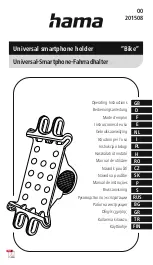
6
FRONT SUSPENSION
V
EHICLE
P
REPARATION
1)
Park the vehicle on a level surface. Set the parking
brake and chock rear wheels. Measure and record the
distance from the center of each wheel to the top of the
fender opening. See Illustration 1.
Illustration 1
2)
Loosen the front lug and hub nuts before raising the
vehicle.
3)
Raise the front of the vehicle and support the frame
with jack stands. Remove the front wheels and set them
aside.
S
KID
P
LATE
R
EMOVAL
(
IF APPLICABLE
)
1)
Remove the bolts holding the differential skid plate to
the front cross member. See Illustration 2. Slide the skid
plate back and remove.
Illustration 2
B
RAKE
H
OSE
R
EPLACEMENT
NOTE: If the master cylinder becomes empty, then the entire
brake system must be bled. Follow manufacturer’s
recommendations for bleeding the entire system.
1)
Separate the passenger side brake line from the brake
hose at the frame rail. Plug line to prevent brake fluid
seepage.
2)
Remove the bolt holding the brake hose to the frame.
See Illustration 3.
Illustration 3
3)
Remove the brake hose banjo bolt at the caliper.
Remove brake hose.
4)
Attach right brake hose RS170109 to the caliper with
new washers and the original banjo bolt. See Illustration 4.
Tighten the bolt to 20 ft. lbs.
Illustration 4
5)
Attach brake hose RS170109 to the brake line and
frame. Tighten the original frame bolt to 7.5 ft. lbs. and the
brake line fitting to 14 ft. lbs.
6)
Repeat steps 1 through 6 to install left brake hose
RS170108 on the driver side.
7)
Bleed the front brakes as follows:
Fill master cylinder reservoir with approved brake fluid.
Attach a clear hose to bleeder valve of right front caliper.
Immerse other end of hose into glass container partially filled
with brake fluid.
Open bleeder valve, and then have a helper press down on
the brake pedal.
Close bleeder valve and repeat process until fluid is clear
and free of bubbles.
Repeat steps for left front caliper.


































